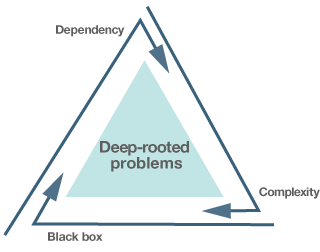
The Diminishing Returns of Information Technology
Economy- English
- 日本語
- 简体字
- 繁體字
- Français
- Español
- العربية
- Русский
Over the past two decades, the IT industry in Japan has put forth bold slogans promising that IT can be used to create a competitive advantage and generate innovation—and it continues to adhere to this approach.
But is this actually realistic? This is what many businesspersons outside the IT industry seem to be wondering. And even some of us within the industry share this doubt.
Ineffective IT
To be fair, IT has unquestionably brought positive results. Just consider what the workplace was like around ten years ago, when finishing one month’s work would often drag into the next month, and processing quarterly results in time for deadlines was frequently a struggle.
It also seems undeniable that improvements in information management across organizations, and the integration of IT systems across departments and functions, has increased efficiency and reduced the amount of labor needed for business processing. These initiatives often come under the umbrella term “enterprise resource planning.” For example, sales information entered into the system to manage sales can be automatically stored in the accounting system.
But even considering such benefits, many are still wondering whether IT is really worthwhile. A more accurate way of posing the question might be: “Are the results that IT is bringing worth the amount of money expended on it?”
Not many people are aware of the scale of Japan’s IT market; it turns out to be enormous, valued at around ¥14 trillion. And this figure does not even include e-commerce transactions and sales of online video games. The largest market worldwide is in the United States, which is around twice the size of the Japanese domestic market. The European Union ranks second, followed very closely by Japan. On a country by country basis, the top three are the United States, China, and then Japan.
Given the enormous size of these IT markets, corporations are channeling a spectacular amount of investment toward IT. The question is whether or not this investment is paying dividends. My impression is that efforts to hasten innovation and gain a competitive edge through IT are not paying off that well. Here I want to examine some of the reasons why.
A Focus on Not Falling Behind
IT has become indispensable to our everyday work. The problem, though, comes down to the systems that directly support these tasks. Up to now, they have covered the entire corporate value chain—from systems to handle accounting and orders to those managing stock and production. Without such information systems, there is no way to keep track of the orders of clients. This shows how deeply information systems are integrated into the work process.
One major problem is that so much money must be expended on information systems to handle ordinary tasks. Certainly, these systems do bring benefits, such as enhancing efficiency and preventing errors, but they can hardly be said to generate a competitive edge or innovation. Nevertheless, there is no going back to the old ways. If it takes a day to send orders now, it is unacceptable to use the old manual approach that might have taken three days. The one-day method using IT might not bring a competitive advantage, but the manual approach will certainly put a company at a disadvantage. In this sense, companies are investing heavily in information systems in order to avoid falling behind their competitors.
Spending on IT by Japanese companies differs by industry, but generally it ranges between 1% and 3% of overall sales. This relatively large expenditure does not really make sense if the only outcome is to avoid a competitive disadvantage. It turns out that around 70% of that amount spent goes to maintaining existing systems. And the IT budget tends to steadily accumulate, rather than decrease, like snow piling up on the ground.
In other words, only around 30% of the IT budget goes to new initiatives—and not all of these are directly linked to forging a competitive advantage. This fact reflects the high probability that the IT budget tends to focus on avoiding a competitive disadvantage.
Three Deep-rooted Problems
What makes it so difficult to keep down the costs required to maintain information systems? There seem to be three reasons in particular.

The first reason is that the systems are a sort of black box. That is to say, the content of the systems is unclear. In many cases there are no documents on hand to explain system design, and even when they are available there are many cases where they do not correspond exactly to the system. This is because during the process of making improvements to a system, such documents are updated infrequently. This means that even when a company is simply making improvements to one aspect of system maintenance, it is necessary to analyze each aspect of the existing system—and performing this work requires a considerable amount of time.
Second, there is the factor of the increasing complexity of systems. Corporate systems are a composite of many optimized systems, which makes it necessary to coordinate the data between them. In other words, there is a need for an interface between the various systems that make up the whole. This has increased the complexity of the task facing companies. If a company sets out to improve one of its systems, there are many other systems that it will have to enhance at the same time.
The third reason concerns dependency. That is to say, companies must depend on a few specific individuals, who are the only ones capable of understanding how the systems function. The situation is such that the “manuals” for these systems only exist within the minds of a few specialized engineers. Because of this situation these engineers spend most of their time maintaining existing systems. Even if this gives the engineers job security, in some cases it robs them of the chance to tackle new technical challenges.
The Limits of Transparency
I would like to take another look at the influence that these three factors have on the high costs associated with information systems and what countermeasures could be taken. Some may think the solution simply comes down to making the processes that comprise a system more transparent. This simple solution sounds attractive but over the years we have seen that it has its limitations.
And this, in turn, raises the question: What should a chief information officer do in response to this situation? Or is a CIO even necessary in the first place?
I will take a look at (this rather delicate) question in my next article on this topic.